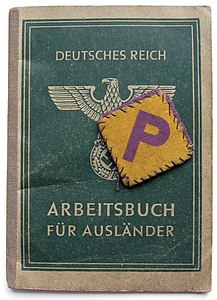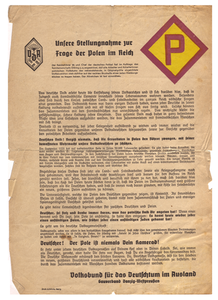
Masuria is an ethnographic and geographic region in northern and northeastern Poland, known for its 2,000 lakes. Masuria occupies much of the Masurian Lake District. Administratively, it is part of the Warmian-Masurian Voivodeship. Its biggest city, often regarded as its capital, is Ełk. The region covers a territory of some 10,000 km2 which is inhabited by approximately 500,000 people.

The Masurians or Mazurs, historically also known as Prussian Masurians, are an ethnic group originating from the region of Masuria, within the Warmian-Masurian Voivodeship, Poland. They number around 5,000–15,000 people. In the 2011 Polish census, 1,376 individuals declared themselves to be Masurian as either a first or a secondary identification. Before World War II and its post-war expulsions, Masurians used to be a more numerous ethnic group found in the southern parts of East Prussia for centuries following the 16th century Protestant Reformation. Today, most Masurians live in what is now Germany and elsewhere.

Szczytno is a town in northeastern Poland with 27,970 inhabitants (2004). It is the seat of Szczytno County in the Warmian-Masurian Voivodship, within the historic region of Masuria.

Chełmno is a town in northern Poland near the Vistula river with 18,915 inhabitants as of December 2021. It is the seat of the Chełmno County in the Kuyavian-Pomeranian Voivodeship.

Leontopodium nivale, commonly called edelweiss, is a mountain flower belonging to the daisy or sunflower family Asteraceae. The plant prefers rocky limestone places at about 1,800–3,400 metres (5,900–11,200 ft) altitude. It is non-toxic and has been used in traditional medicine as a remedy against abdominal and respiratory diseases. Its leaves and flowers are covered with dense hairs, which appear to protect the plant from cold, aridity, and ultraviolet radiation. It is a scarce, short-lived flower found in remote mountain areas and has been used as a symbol for alpinism, for rugged beauty and purity associated with the Alps and Carpathians. It is a national symbol of several countries, specifically Bulgaria, Austria, Slovenia, Switzerland, and Italy. In Romania it was declared a "monument of nature" in 1931. The Edelweiss day is celebrated on 5 March. According to folk tradition, giving this flower to a loved one is a promise of dedication.

The yellow badge, also known as yellow patch, Jewish badge or yellow star, was a badge that Jews were ordered to wear by some caliphates during the Middle Ages, some European powers during the Medieval and early modern periods, and Nazi officials in World War II. The badges marked the wearer as a religious or ethnic outsider, often as a badge of shame.

Nazi concentration camp badges, primarily triangles, were part of the system of identification in German camps. They were used in the concentration camps in the German-occupied countries to identify the reason the prisoners had been placed there. The triangles were made of fabric and were sewn on jackets and trousers of the prisoners. These mandatory badges of shame had specific meanings indicated by their colour and shape. Such emblems helped guards assign tasks to the detainees. For example, a guard at a glance could see if someone was a convicted criminal and thus likely of a tough temperament suitable for kapo duty.

The uniforms and insignia of the Schutzstaffel (SS) served to distinguish its Nazi paramilitary ranks between 1925 and 1945 from the ranks of the Wehrmacht, the German state, and the Nazi Party.
Awards and decorations of Nazi Germany were military, political, and civilian decorations that were bestowed between 1923 and 1945, first by the Nazi Party and later the state of Nazi Germany.

Barczewo is a town in Olsztyn County, Warmian-Masurian Voivodeship, Poland. It is situated 20 km northeast of Olsztyn, in the historic region of Warmia. As of December 2021, the town has a population of 7,483.
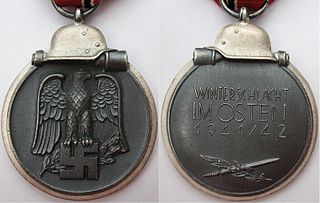
The Eastern Medal, officially the Winter Battle in the East 1941–42 Medal, was a military award of the Wehrmacht which was created by ordinance of Adolf Hitler on 26 May 1942.

Wielbark is a town in Szczytno County, Warmian-Masurian Voivodeship, in northern Poland. It is the seat of the gmina called Gmina Wielbark. It lies approximately 19 kilometres (12 mi) south of Szczytno and 52 km (32 mi) south-east of the regional capital Olsztyn. It is part of historic Masuria.

A prison uniform is a set of standardized clothing worn by prisoners. It usually includes visually distinct clothes worn to indicate the wearer is a prisoner, in clear distinction from civil clothing.

Wojciech Kętrzyński, was a Polish historian and the director of the Ossolineum Library in Lemberg, then the capital of Galicia, Austrian Empire. He focused on Polish history at a time when Poland was partitioned between foreign powers. He opposed the idea of Germanization and assisted in the January Uprising for Poland's cause. In 1861 he legally changed his name and became a Polish national.

A badge of shame, also a symbol of shame, a mark of shame or a stigma, is typically a distinctive symbol required to be worn by a specific group or an individual for the purpose of public humiliation, ostracism or persecution.

Polish decrees, Polish directives or decrees on Poles were the decrees of the Nazi Germany government announced on 8 March 1940 during World War II to regulate the working and living conditions of the Polish workers (Zivilarbeiter) used during World War II as forced laborers in Germany. The regulation intentionally supported and even created anti-Polish racism and discrimination on the grounds of ethnicity and racial background.
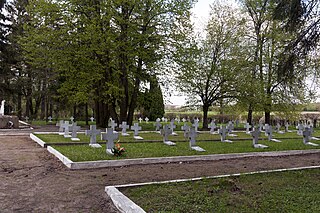
Stalag I-B Hohenstein was a German World War II prisoner-of-war camp located 2 kilometres (1.2 mi) west of Hohenstein, East Prussia.
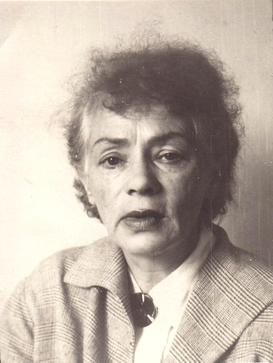
Cecylia Vetulani was a Polish art historian and conservator-restorer who did research mostly in the field of Warmia and Masuria folk art. She was a custodian of the Museum of Warmia and Mazury in Olsztyn (1950–1956).

The Radio Operator & Air Gunner's Badge is a commonly accepted title for the Luftwaffen-Fliegerschützen-Bordfunker-und Bordmechanikerabzeichen. It was a German military decoration awarded to radio operators, air gunners, and mechanics who were members of the German Air Force (Luftwaffe). This is given after they completed two months training or had taken part in at least five operational flights. If wounded during an operational flight, the badge could be awarded and worn earlier. Later in June 1942, a separate badge was introduced for air gunners and flight engineers. That badge had the same qualifications.

The Monument to World War II Orthodox victims in Białystok is a privately funded memorial commemorating the memory of 5,000 Orthodox Christians from the Białystok region who perished in World War II and during the postwar repressions in Stalinist Poland.

